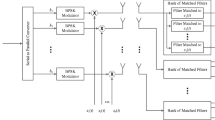Abstract
This paper presents mutual information achieved by a Massive multi-input multi-output (Ma-MIMO) systems on a block Rayleigh-fading Channels. Mutual information represents the highest achievable spectral efficiency (SE) in Ma-MIMO systems. Fast fading causes the loss in SE which is amplified by using multiple transmit antennas. The channel model considered here is block Rayleigh-fading Channels which resembles the practical scenario of cellular communication. Kronecker model is considered for modeling the spatially correlated channels. Minimum mean square error with successive interference cancellation (MMSE-SIC) is implemented to detect the channel and estimate the SE in the Uplink and Downlink channels. The simulation result shows linear MMSE and MMSE-SIC detector’s achievable SE for the Ma-MIMO systems.




Similar content being viewed by others
References
Larsson, E.G., Edfors, O., Tufvesson, F., Marzetta, T.L.: Massive MIMO for next generation wireless systems. IEEE Commun. Mag. 2, 186–195 (2014)
Ngo, H.Q., Larsson, E.G., Marzetta, T.L.: Energy and spectral efficiency of very large multiuser MIMO systems. IEEE Trans. Commun. 4, 1436–1449 (2013)
Li, X., Bjornson, E., Larsson, E.G., Zhou, S., Wang, J.: A multi-cell MMSE precoder for massive MIMO systems and new large system analysis. In: Global Communications Conference (GLOBECOM), 2015 IEEE, pp. 1–6. IEEE (2015)
Bjornson, E., Sanguinetti, L., Hoydis, J., Debbah, M.: Optimal design of energy-efficient multi-user MIMO systems: is massive MIMO the answer. IEEE Trans. Wirel. Commun. 6, 3059–3075 (2015)
Bjornson, E., Larsson, E.G., Debbah, M.: Massive MIMO for maximal spectral efficiency: How many users and pilots should be allocated? IEEE Trans. Wirel. Commun. 15(2), 1293–1308 (2016)
Sun, C., Yang, Y., Yuan, Y.: Low complexity interference alignment algorithms for desired signal power maximization problem of MIMO channels. EURASIP J. Adv. Signal Process. 2012(1), 137 (2012)
Lu, L., Li, G.Y., Swindlehurst, A.L., Ashikhmin, A., Zhang, R.: An overview of massive MIMO: benefits and challenges. IEEE J. Sel. Top. Signal Process. 5, 742–758 (2014)
Huang, H., Papadias, C.B., Venkatesan, S.: MIMO Communication for Cellular Networks. Springer, New York (2011)
Foschini, G.J., Golden, G.D., Valenzuela, R.A., Wolniansky, P.W.: Simplified processing for high spectral efficiency wireless communication employing multi-element arrays. IEEE J. Sel. Areas Commun. 11, 1841–1852 (1999)
Li, X., Bjornson, E., Zhou, S., Wang, J.: Massive MIMO with multi-antenna users: when are additional user antennas beneficial. In: 2016 23rd International Conference on Telecommunications (ICT), pp. 1–6. IEEE (2016)
Ha, C.-B., Jang, B.-J., Song, H.-K.: Adaptive power control using large scale antenna of the massive MIMO system in the mobile communication. KSII Trans. Internet Inf. Syst. (8) (2015)
Ren, P., Zhang, C., Liu, X., Liu, P., Ci, S.: Wireless internet. In: 6th International ICST Conference, WICON 2011, Xi’an, China, 19–21 October (2011)
Ding, M., Blostein, S.D.: Maximum mutual information design for MIMO systems with imperfect channel knowledge. IEEE Trans. Inf. Theory 10, 4793–4801 (2010)
Gao, Z., Dai, L., Wang, Z.: Channel estimation for mmwave Ma-MIMO based access and backhaul in ultra-dense network. In: 2016 IEEE International conference in Communications(ICC), pp. 1–6. IEEE (2016)
Kermoal, J.P., Schumacher, L., Pedersen, K.I., Mogensen, P.E., Frederiksen, F.: A stochastic MIMO radio channel model with experimental validation. IEEE J. Sel. Areas Commun. 20(6), 1211–1226 (2002)
Bjorson, E., Ottersten, B.: A framework for training-based estimation in arbitrarily correlated rician MIMO channels with rician disturbance. IEEE Trans. Signal Process. 58(3), 1807–1820 (2010)
Li, X., Gao, X.Q., McKay, M.R.: Capacity bounds and low complexity transceiver design for double-scattering MIMO multiple access channels. IEEE Trans. Signal Process. 58(5), 2809–2822 (2010)
Musavian, L., Nakhai, M.R., Dohler, M., Aghvami, A.H.: Effect of channel uncertainty on the mutual information of MIMO fading channels. IEEE Trans. Veh. Technol. 56(5), 2798–2806 (2007)
Li, X., Bjomson, E., Larsson, E.G., Zhou, S., Wang, J.: A multicell MMSE detector for massive MIMO systems and new large system analysis. In: Proc. IEEE GLOBECOM (2015)
Author information
Authors and Affiliations
Corresponding author
Rights and permissions
About this article
Cite this article
Damodaran, S.P., Srinivasan, V.K. Mutual information of massive MIMO systems on block Rayleigh-faded channels. Cluster Comput 22 (Suppl 4), 9543–9550 (2019). https://doi.org/10.1007/s10586-018-2509-0
Received:
Revised:
Accepted:
Published:
Issue Date:
DOI: https://doi.org/10.1007/s10586-018-2509-0




